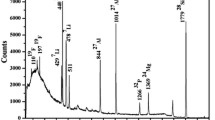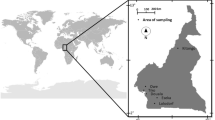Abstract
A non-destructive, in situ current normalized particle induced gamma-ray emission methodology has been standardized for quantification of fluorine (F) in soil samples from Punjab state, India. The samples were irradiated using 4 MeV proton beam from the Folded Tandem Ion Accelerator at BARC, Mumbai. The gamma rays of energies 197 and 478 keV arising from 19F(p, p′γ)19F and 7Li(p, p′γ)7Li nuclear reactions were measured using high resolution gamma-ray spectrometry. The concentration of fluorine in soil samples was found to vary between 414 and 5,746 mg kg−1.
Similar content being viewed by others
Explore related subjects
Discover the latest articles, news and stories from top researchers in related subjects.Avoid common mistakes on your manuscript.
Introduction
It is a well-established fact that long exposure to fluoride could be harmful to bones and teeth. It has been estimated that in India close to 62 million people are affected by water contaminated with fluoride. Rajni Sharma [1] has reported that the concentration of fluoride in drinking water from Amritsar, Bhatinda, Faridkot, Fatehgarh Sahib, Firozepur, Gurdaspur, Mansa, Moga, Muktsar, Patiala and Sangrur Districts of Punjab, a state located in the north western part of India between 29.5°N and 32.5°N latitude and between 73.8°E and 76.9°E longitude, is higher than the permissible level of 1.5 mg kg−1 recommended by World Health Organization [2]. Figure 1 shows the district wise map of Punjab State. The main sources of fluoride are minerals like fluorite, fluorapatite and cryolite [3] which are present deep in earth’s crust. Fluorine is also known to be present in significant amount in products of coal combustion besides pesticides and fertilizer [4]. Punjab being the foremost Indian State in agriculture production during the green revolution has been a site for indiscriminate application of pesticides and fertilizers in its soil. Therefore, it should not be surprising if soil itself could be an important source leading to the contamination of drinking water by fluoride. Rajbir Kaur et al. [5] have reported the concentration of fluorine in soil samples collected from locations in and around Chandigarh the capital city of Punjab State which so far seems to have not been affected by fluoride contaminated water. Fluorine concentration in soil is normally determined by chemical separation followed by fluoride detection employing techniques like colorimetry, spectrophotometry or ion selective electrodes [6–8]. Saha and Kundu [9] have demonstrated that fluorine in soil can also be measured using ion chromatography. These techniques are however prone to under estimation of the actual value in the case of 100 % chemical recovery being not attained.
In the present work, nuclear analytical technique namely particle induced gamma ray emission (PIGE) has been used which is independent of chemical recovery factor. PIGE is sensitive technique for low Z elements (Z < 17) especially for lithium and fluorine [10, 11]. It finds applications in many fields including pharmaceuticals [11], glass [12], teeth [13, 14], aerosols [15] and geological and environmental reference materials [16, 17]. This makes it complementary to techniques like particle induced X-ray emission (PIXE), X-ray fluorescence (XRF) and neutron activation analysis (NAA). PIGE involves measurement of prompt gamma-rays emitted from the nuclear reactions and inelastic scattering when energetic charged particle beam falls on the target.
PIGE is an accelerator based online technique which involves measurement of prompt gamma-rays. Accelerator based experiments may be associated with variation in the beam current during the irradiation. Therefore beam current normalization is an important aspect in PIGE. The normalization can be done either by measuring the beam current directly from conducting target or by making use of Rutherford backscattering spectrometry (RBS) [18] or from the target (powdered sample) mixed with graphite if target is nonconducting.
In the present work, soil samples collected from sites located in different districts of Punjab were investigated for their fluorine content. For the determination of F in soil, we have standardized an in situ PIGE methodology for non-destructive determination of F in soil samples using 4 MeV proton beam from the Folded Tandem Ion Accelerator (FOTIA) located at BARC in Mumbai, India. Li was used as in situ current normalizer [19]. In situ current normalizer is the element which has high sensitivity towards PIGE and it should not be present in the sample of interest.
Experimental
Soil samples were collected from different locations of Punjab, where fluoride contamination in ground water has been reported previously. The samples were collected at a depth ranging 5–30 cm by using normal auger method. The samples were dried below 60 °C for 12 h. For determination of F, in soil samples, in situ current normalized PIGE methodology was adopted [19]. Fluorine standards were prepared by mixing homogenously varying amount of CaF2 (30–50 mg) and constant amount of Li2CO3 (~20 mg) in cellulose matrix. Soil samples were prepared by homogeneously mixing soil samples (~300 mg) with constant amount Li2CO3 (~20 mg) in cellulose matrix. For validating the method, standard reference material from NIST (1645a) was analyzed for F content.
The target pellets were irradiated, under high vacuum (10−6 torr) conditions, with 4 MeV proton beam (beam current 5–10 nA) from the FOTIA at BARC. The time of target irradiation was kept 10–60 min depending on the F concentration in the targets. The prompt gamma-rays of 197 and 478 keV from 19F(p, p′γ)19F and 7Li(p, p′γ)7Li nuclear reactions were measured using 30 % HPGe detector coupled with PC based 8 k multi-channel analyzer (MCA). The detector was kept in a direction placed perpendicular to the beam axis at a distance of 5 cm from the target ladder. This helps in minimizing the Doppler broadening of gamma-rays. The gamma-ray spectra of samples were analyzed using pulse height analysis software (PHAST) [20].
Calculations
Lithium normalized sensitivity of fluorine (S F) was used for determination of F in the soil samples which was calculated using the following relation:
where (CPS)F is the count rate of 197 keV gamma-ray of F, m F is the concentration of F in mg kg−1 in the pellet and S Li, the sensitivity of Li obtained using following relation:
where (CPS)Li is the count rate of 478 keV gamma-ray of Li, and m Li is the concentration of Li in mg kg−1 in the pellet. The concentration of F in soil samples was determined using the sensitivity of F obtained from the Eq. 1. For normalizing the effect of beam current fluctuations an in situ current normalizing element (Li) was added in constant amount to every target. The count rate of gamma-line of interest (197 keV for F) are normalized by the count rate of gamma-ray from in situ element (478 keV Li) counts.
Results and discussion
Figure 2 shows the gamma-ray spectrum of a representative soil sample. The gamma lines of interest namely 197 keV from 19F and 478 keV from 7Li can be distinctly observed. In the present work, Li normalized sensitivity of F was used to determine the concentration of F in soil samples collected from different districts of Punjab. For method validation one of the NIST SRMs, 1645a, was analyzed for F. The F concentration obtained in this SRM was found to be in good agreement with that of the expected value of the F with an uncertainty of 2.0 %. The results of F concentrations in various soil samples are presented in Table 1 which in addition shows the name of the locations and the names of the district in which they are located. The uncertainties in F concentrations results are the propagated one and they are due to the sample and standard masses (0.1–0.5 %), counting statistic and peak fitting errors (0.5–2.0 %). It can be observed that the concentration of fluorine in the locations studied ranged between 414 and 5,746 mg kg−1. The minimum was observed in the sample from Patiala District and the maximum in the sample from Bathinda District. The mean fluorine concentration was obtained as 1,398 ± 94 mg kg−1. The data obtained in the present work were compared with that obtained by Kaur et al. [5]. The aforementioned researchers have shown that the minimum and maximum concentration of fluorine in soil where fluoride contamination in ground water has so far not been observed ranged between 275 and 869 mg kg−1 with a mean of 522 ± 58 mg kg−1. Therefore it can be stated that the mean fluorine concentration of soil from region affected by elevated level of fluoride in its ground water is nearly three times more than that observed from the region which is unaffected by fluoride contamination of its ground water.
Conclusion
The concentration of fluorine in soil in region affected by fluoride contaminated water is significantly high. It can be further stated that the nuclear analytical technique PIGE with an in situ current normalization approach, could be successfully used for such type of studies. It would be interesting to carry out further work in this direction to make more concrete studies as the body of data is still scanty.
References
Sharma R (2012) Asian J Adv. Sci Eng Res 1:1–7
Arlappa N, Aatif QI, Srinivas R (2013) Int J Res Dev Health 1:97–102
Blagojevic S, Jakovljevic M, Radulovic M (2002) J Agric Sci 47(1):37–44
Eyde B (1985) Fresenius Z Anal Chem 320:41–44
Kaur R, Oswal M, Singh A, Kaur N, Singh KP, Behra BR, Singh G, Kumar A (2010) Proc DAE Symp Nucl Phys 55:778–779
McQuaker NR, Gurney M (1977) Anal Chem 49:53–56
Pardillo MB, Martinez VP, Adelantado JVC, Reig FB (1989) Microchem J 39:182–189
Eyde B (1983) Fresenius Z Anal Chem 316:299–301
Saha JK, Kundu S (2011) Commun Soil Sci Plant Anal 34:181–188
Savidou A, Aslanoglou X, Paradellis T, Pilakouta M (1999) Nucl Instrum Methods B 152:12–18
Kiss ÃZ, Koltay E, Nyako B, Somorjai E, Anttila A, Räisäsne J (1985) J Radioanal Nucl Chem 89:123–141
Nsouli B, Bejjani A, Negra SD, Gardon A, Thomas JP (2010) Anal Chem 82:7309–7318
Mosbah M, Metrich N, Massiot P (1991) Nucl Instrum Methods B 58:227–231
Salah H, Arab N (2007) J Radiochem Nucl Sci 8:31–34
Yosnda K, Hai VH, Nomachi M, Sugaya Y, Yamamato H (2007) Nucl Instrum Methods B 260:20–27
Macias Edwards S, Radcliffe C, David R, Lewis CW, Sawicki CR (1978) Anal Chem 50:1120–1124
Valkovic O, Jaksic M, Fazinic S, Valkovic V, Moschini G, Menapace E (1995) Nucl Instrum Methods B 99:372–375
Tripathi R, Sodaye S, Tomar BS (2004) Nucl Instrum Methods A 533:282–286
Chhillar S, Acharya R, Pai RV, Sodaye S, Mukerjee SK, Pujari PK (2012) J Radioanal Nucl Chem 293:437–441
Mukhopadhyay PK (2001) Proceedings of the symposium on Intelligent Nuclear Instrumentation (INIT-2001), Bhabha Atomic Research Centre, Mumbai 307-313
Acknowledgments
The authors are thankful to the operating staff of the FOTIA Accelerator, Bhabha Atomic Research Centre, Mumbai for irradiating the samples. The help provided by Mr. Amol D Shinde and Ms. N. Kaur for the experimental work is also thankfully acknowledged. They would also like to place in record their special thanks to Prof. B.S. Dhillon, Vice Chancellor of Panjab Agriculture University, Ludhiana, Punjab for the help extended in procurement of soils from different districts of Punjab State. One of us (AS) would like to thank the UGC-DAE Consortium for Scientific Research for supporting his research stay at BARC under the program CRS M-129/169 granted to him. Another author (SC) thanks HBNI, DAE for financial assistance. Authors thank Dr. A. Goswami, Head, RCD, BARC for his support. The suggestions given by Dr. A.V.R. Reddy Head of Analytical Chemistry Division of Bhabha Atomic Research Centre, Mumbai in the preparation of the manuscript is duly acknowledged.
Author information
Authors and Affiliations
Corresponding author
Rights and permissions
About this article
Cite this article
Srivastava, A., Chhillar, S., Singh, D. et al. Determination of fluorine concentrations in soil samples using proton induced gamma-ray emission. J Radioanal Nucl Chem 302, 1461–1464 (2014). https://doi.org/10.1007/s10967-014-3661-5
Received:
Published:
Issue Date:
DOI: https://doi.org/10.1007/s10967-014-3661-5






